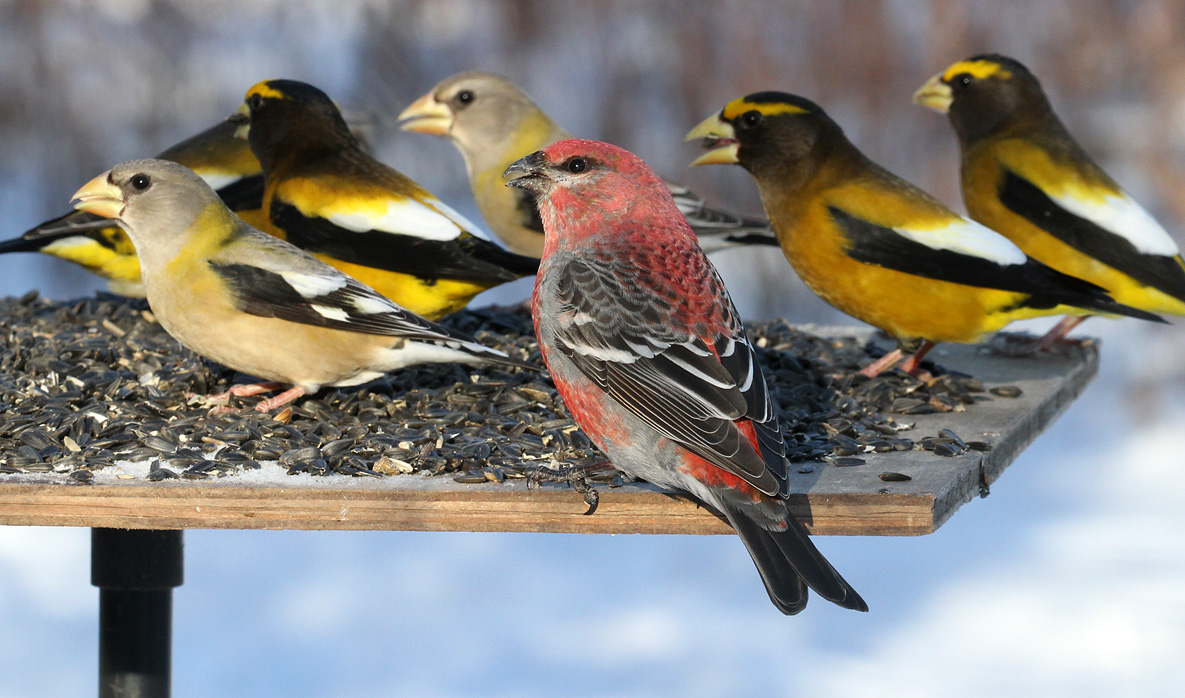Irruption Alert: Like an Incoming Tide, Here Come More Finches —
by Matt Young —
While the wave of Evening Grosbeaks that moved through the eastern upper half of southern Canada and northern United States has been the big news the last few weeks, many of the other finches continue to march southward. And many species will be findable if you put in a little work.
For much of the period between 2010-2019 it seemed like finch irruptions were at a many decade low…. so when they move it’s often a welcomed event for the birding, ornithological and nature-loving communities. Many have said to me over the years, “ah, nothing better than a solid finch irruption to get us through the winter months.” It won’t be a superflight of finches in the east like it was two years ago, when we all really needed it as we were in the deep throes of COVID uncertainty, but it’s going to be a good finchy winter for many of us in the eastern half of the United States and some parts of the west. It’ll certainly bring many of us some well needed winter season “ornitherapy”.

Purple Finches, often a harbinger of a finch flight in the east, can now be found in good numbers in the southern states with a few making it to the Gulf Coast. Look for numbers to continue to push southward into the Gulf States. It should be noted that the western subspecies (ssp. californicus) is largely sedentary along the coastal states, but any Purple Finch found in interior areas of the west should be recorded since most birds are likely of the eastern subspecies (ssp. purpureus). The flight calls are different (Hahn et al. 2021).

As said above, in the east Evening Grosbeaks (Type 3) have made an impressive push southward like two years ago, and despite the nickname of “grocery-beaks”, it’s such a welcome sight for many of us. This iconic finch has already been reported in North Carolina, Virginia, Tennessee, Iowa, and Missouri in the east, and numbers are increasing and building in some locations of the western Great Lakes with Ryan Brady reporting 130+ at his feeders in northwestern Wisconsin. Type 1, the irruptive call type in the west, appears to have moved around to parts of the west already too. And, a Type 4 was found in Texas, which is thought to be rare to uncommon outside of the Rockies, but more recordings of Evening Grosbeaks overall are needed throughout the west!

Following several conservation listings, the Evening Grosbeak has garnered conservation attention from the recently formed Road to Recovery (R2R) Initiative as it was called out as one of 91 bird Species on the Brink of Endangerment (see below for more). Also stay tuned for more about a Finch Research Network feedercam highlighting this much-loved species.

Pine Grosbeak are pushing south nicely as well now, and with relatively subpar fruit crops in the east look for random sightings to perhaps pop-up further south than usual. Also look for them to be feeding in towns on crabapples but given the crops appear to be on the poor side, check ash trees as they love the samaras, and check conifer forests of spruce and larch, as they love to feed on the tips of branches of the most recent growth.
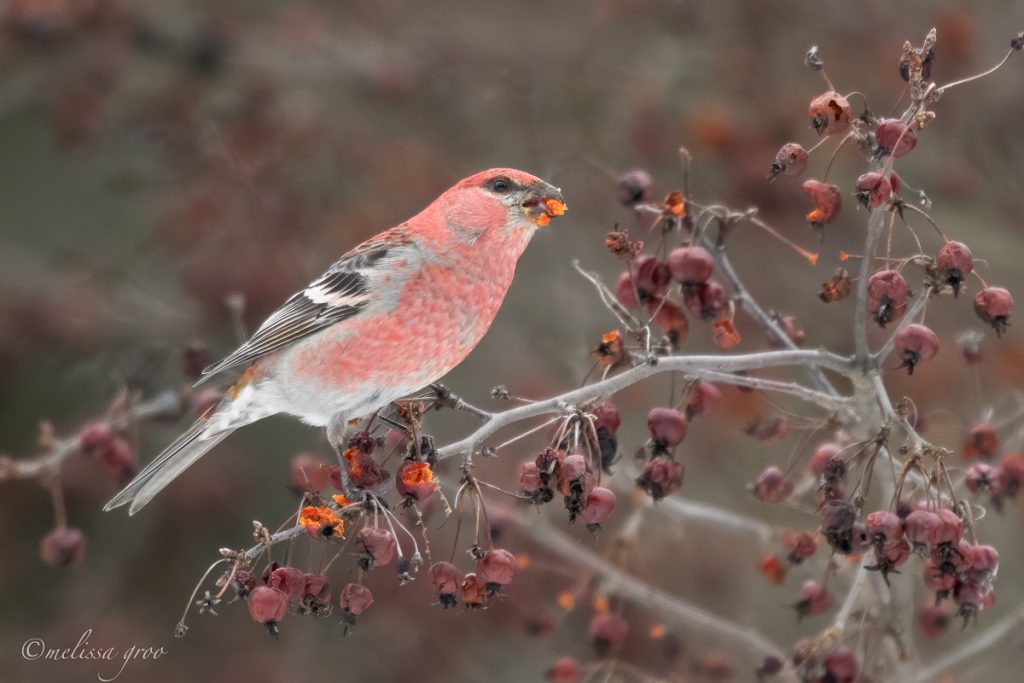
Birds have been reported in growing numbers in southern Ontario and Quebec, and the northern parts of the western Great Lakes. Sightings are starting to increase in Minnesota, Wisconsin, Michigan, Maine, New Hampshire, Vermont and New York as well, with birds reported as far south as western NY.

The Common Redpoll movement has been a bit slow to materialize, but there are signs that a small to moderate irruption could still take place. Some birds are probably stopping to feed on the last remaining birch and alder crops, and the great spruce crops across the western boreal, but given alder and birch crops are overall poor as Tyler Hoar reported in the Winter Finch Forecast, we expect redpolls to continue to slide southward and be around in the Great Lakes, Northeast and some interior Western States as winter sets in. Hopefully a few Hoary Redpolls will do their usual thing and tag along too.
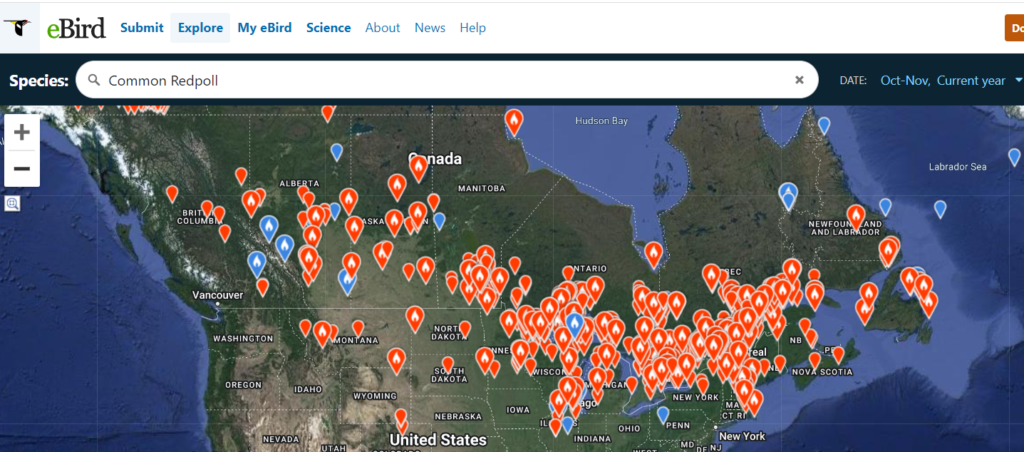
Small numbers of Red Crossbills and Pine Siskins are also on the move, and there’s a few interesting small scale movements to highlight it seems.
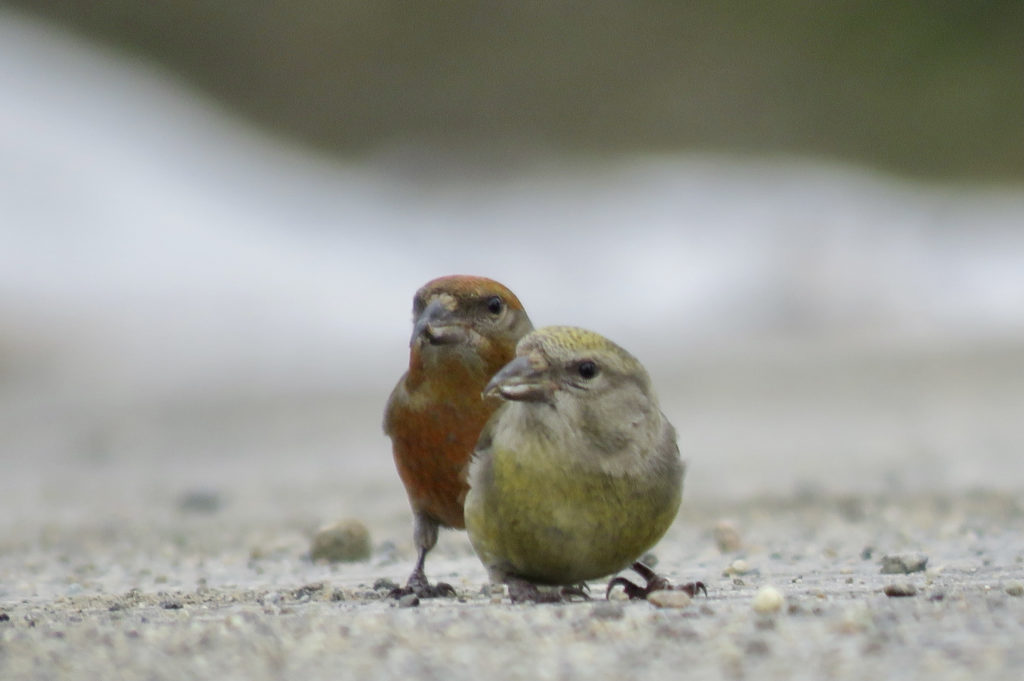
Type 2 is moving west to east from the Rockies out into Plains states of Kansas, Nebraska, Missouri and Texas. The recordings received so far have been all type 2, which is the typical type that does this.

White-winged Crossbills are mostly gorging themselves on the bumper spruce crop across the western part of the continent, but a few Type 12 Red Crossbill (formerly eastern Type 10…stay tuned for more on this soon) are starting to show signs of doing their typical movements down the east coast from the Maine and the Maritimes to Cape Cod, Massachusetts, NYC and Long Island, and points south to Cape May, NJ and Delaware (please record these birds so we can confirm as many as possible, but recordings received so far have all been of this call type). Look for this to continue and perhaps pick up in Dec-Jan as birds will move to, and linger at coastal areas where they will feed on Pitch Pine and Japanese Black Pine.
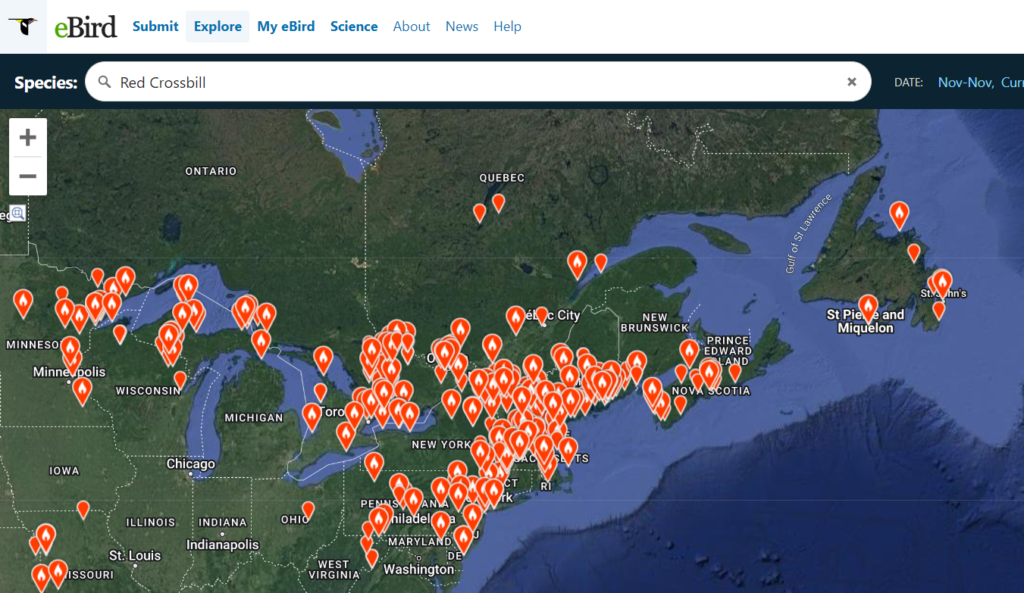
Now Pine Siskins always move in at least small numbers in the east every year, and that seems to be the case this year, but it also appears that birds could be moving from west to east in the same areas that Type 2 Red Crossbills appear to be moving (from perhaps Colorado and New Mexico to Kansas and Texas) as well. I’m not sure I’ve seen this or noticed this before, but it seems plausible given the abundance of reports in east Texas and paucity of reports in the rest of the Gulf States.
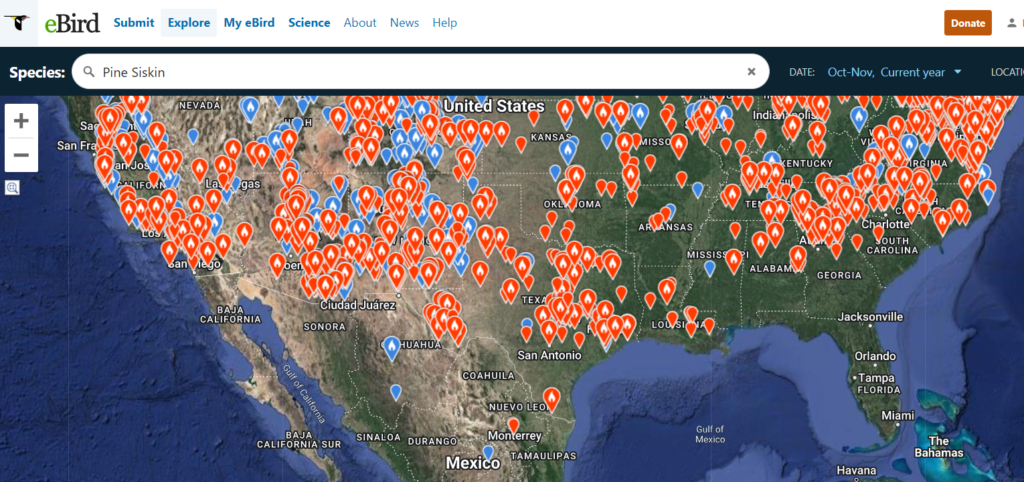
Maybe they’re moving into to Texas from all directions, but this is something perhaps worth watching.

Lastly, the Bohemian Waxwing, a gorgeous honorary finch irruptive that follows fruit crops like the Pine Grosbeak in the northeast, is making an earlier than normal push into the northeastern states. What fun this could be if the irruption builds, which I suspect it will.
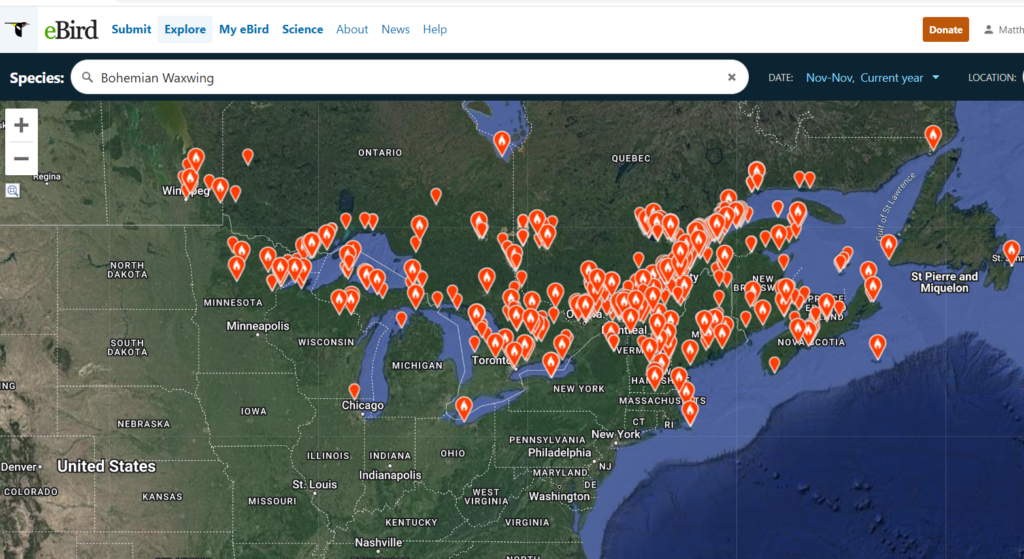
Redpolls, siskins and crossbills will sprinkle the landscape this winter, and it’s no doubt going to be a banner year for Evening Grosbeaks in the east, and by Thanksgiving (here in the States), someone in the mountains of North Carolina will look out their window to see a flock of these charismatic sunflowing chomping jet fliers. Additionally, it’s just a matter of days before more Purple Finches land along areas of the Gulf Coast, and Pine Grosbeaks make a push into Massachusetts and maybe Connecticut (I’m really rooting for a few to show up in Pennsylvania or northern NJ), so expect finches to provide some much needed nature therapy at its finest this winter……and Bohemian Waxwings might provide the cherry on top to a nice winter of irruptives to brighten the landscape.
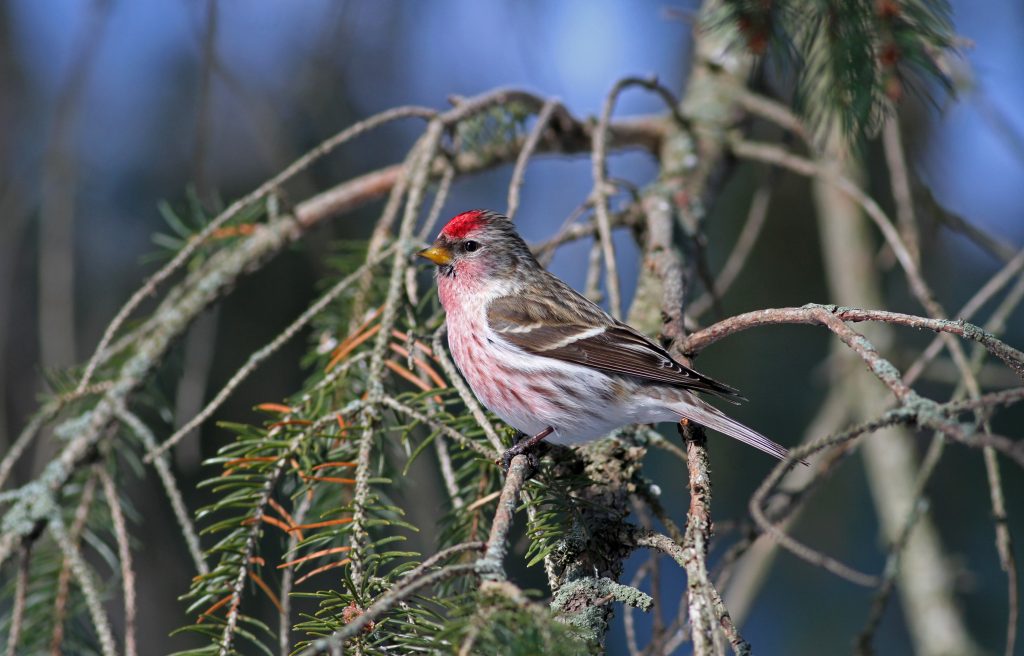
Cover Photo Credit Ryan Brady
T. P. Hahn, Y. Kuang, L. M. Wigger, K. P. Kreuger, M. A. Young. 2021. Eastern and western Purple Finches (Haemorhous purpureus) produce categorically distinct flight calls. Poster for The Society of Integrative and Comparative Biology.
If people are looking for a nice holiday present now that the Holiday season is here, there are a few short sleeve Ts left of the Winter Finch Forecast and Evening Grosbeak Road to Recovery shirts
If those are sold out, please check out this year’s awesome Finch Research Network x Bird Collective apparel series released a couple weeks ago.

The Evening Grosbeak Road to Recovery Project is a collaboration of the Western Pennsylvania Conservancy’s Natural Heritage Program (PNHP), the Carnegie Museum of Natural History’s Powdermill Avian Research Center and The Finchmasters – Finch Research Network.
#birds #birding #conservation #tshirt
The Finch Research Network (FiRN) is a nonprofit, and has been granted 501c3 status. FiRN is committed to researching and protecting finch species like the Cassia Crossbill, Evening Grosbeak, Rosy-Finches, finches of Hawaii (aka the honeycreepers) and more. The Evening Grosbeak has declined 92% since 1970. We are fundraising around an Evening Grosbeak Road to Recovery project in addition to a student research project, so please think about supporting our efforts and making a small donation at the donate link below.
Donate – FINCH RESEARCH NETWORK (finchnetwork.org)
We can also be found on FB (and on Instagram and Twitter) at https://www.facebook.com/thefinchmasters and also on FB at Finches, Irruptions and Mast Crops.

